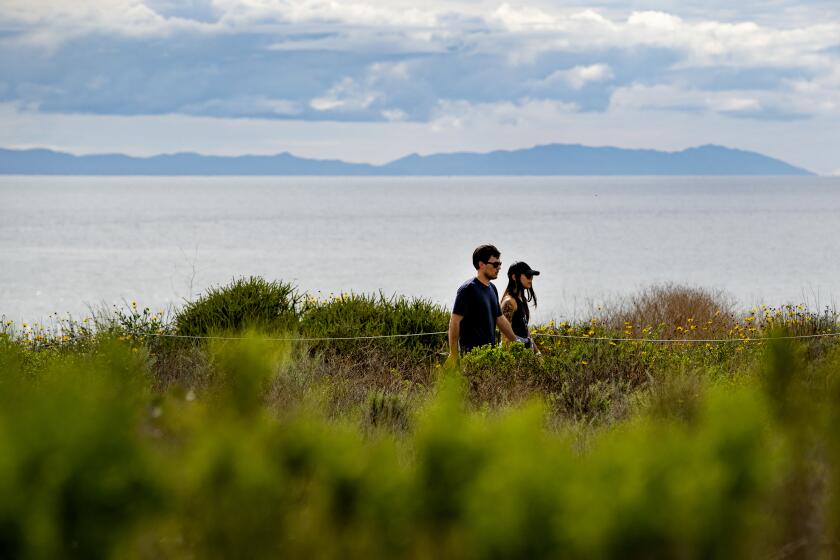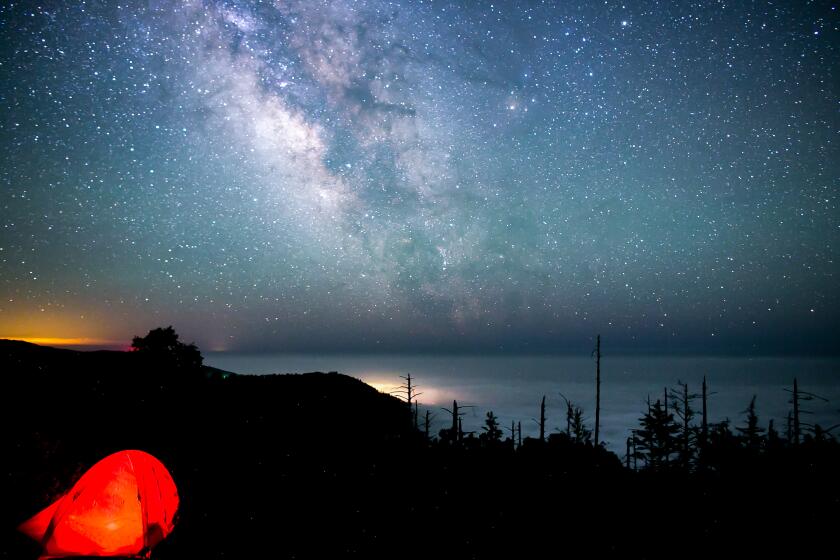That Long Highway Is Far From Lonesome
For Angelenos craving a quick weekend getaway, Las Vegas was always a safe bet. With just 272 miles of often desolate freeway separating the two cities, fortune hunters with full gas tanks and pockets burning with cash could head out of town on a Friday evening and be cruising the Strip well before midnight.
But these days, after a decade of jackpot-size growth in the Inland Empire, Victor Valley and Sin City, that devil-may-care road trip is becoming more of a gamble. A jaunt on Interstate 15 that used to take 4 1/2 hours can easily clock in at closer to six or even eight hours during holiday weekends and other peak travel times.
That trend alarms tourism officials in Las Vegas, where Southern Californians comprise about 30% of the city’s 36 million visitors. The vast majority of them travel by car on one four-lane artery, Interstate 15. (The San Francisco Bay Area, Las Vegas’ second-biggest tourism market, accounts for just 5%.)
“Our concern is that people may do it once or twice and then decide they don’t want to do it again because it’s too much of a hassle,” said Rob Powers, a spokesman for the Las Vegas Convention and Visitors Authority.
He called crowding on Interstate 15 “perhaps the single most important infrastructure issue facing the Nevada resort industry.”
The increased congestion hasn’t dampened the affinity of Southern Californians for Las Vegas, which consistently ranks as one of the top weekend destinations in surveys by the Automobile Club of Southern California.
From 1991 to 2000, Interstate 15 traffic near the California-Nevada border swelled from 22,000 vehicles a day to 35,000 vehicles a day, a 59% increase, according to Caltrans statistics.
Tourism experts expect those numbers to continue to grow in 2002 because of the public’s reluctance to fly since the Sept. 11 terrorist attacks.
During October and November, northbound traffic on Fridays at the Nevada state line rose 16% and 11%, respectively, compared with the previous year, according to the Nevada Department of Transportation. In other words, an additional 14,645 and 12,955 cars, trucks, vans and SUVs were sharing the same two lanes. It doesn’t take a traffic engineer to figure out what the results were.
“Coming back from Las Vegas on a Sunday or the Monday after a long weekend, it’s almost a 100% guarantee you will get a lot of congestion on that I-15 corridor,” said Marie Montgomery, a AAA spokeswoman. “People know about that, and they either prepare for it and try to leave at a different time, or they put up with it.”
But Las Vegas tourism officials aren’t taking Southern California’s tourist traffic for granted. In 2000, the Convention and Visitors Authority hired a private traffic consultant at $5,000 a month to lobby federal, state and local government officials in both states for Interstate 15 construction projects.
Two years ago, Nevada broke ground on a $45.5-million freeway widening project that, by its completion next year, will add an additional southbound lane from Las Vegas to the state line in Primm. A second project to add a third northbound lane from Primm to Las Vegas is scheduled to begin in 2004.
Officials focused on easing southbound traffic first because those leaving-Las Vegas crowds are usually the worst. Californians tend to stagger their arrival times from Thursdays through Saturdays and to flood out of the city en masse on Sunday afternoons or the last day of holiday weekends, said Bob Mckenzie, a spokesman for the Nevada Department of Transportation.
Over the last Thanksgiving weekend, for instance, 35,089 vehicles entered Nevada by way of Interstate 15 that Friday, but 48,447 left the state via the same route that Sunday.
“People who live with the traffic in California, what they see as a traffic jam isn’t necessarily the same thing we see as a traffic jam,” Mckenzie said. “You have a higher tolerance for traffic than we do.”
Upgrades are planned for the California side of Interstate 15 as well. Caltrans is scheduled to begin work this spring on a $178-million project to add an additional traffic lane in each direction on the 29-mile stretch from Victorville to Barstow.
That area has become particularly susceptible to weekend bottlenecks, said Holly Kress, a spokeswoman for the California Department of Transportation.
As was the case in Nevada, the work will be done on the southbound side of Interstate 15 first, with construction of the northbound lane expected to begin early next year.
As an indication of the freeway’s significance, Nevada is contributing $10 million of its own federal highway funds to Caltrans for the widening project.
In the mostly open desert from Barstow to the Nevada state line, Caltrans’ widening work will be more modest. An 18-mile-long truck lane is already under construction, to run south from the Halloran summit to Baker and another truck lane will be added on a 3.6-mile segment outside Barstow.
Truck lanes improve traffic flow by getting slow-moving vehicles out of the way on hills. They are “not the ultimate fix,” Kress said, but the best Caltrans can do on a limited budget.
In the short run, the road crews could slow the adjacent lanes of traffic. Although two lanes will remain open in each direction, speed limits are reduced. To limit delays, Caltrans is keeping its workers off the route from Friday afternoons to Monday mornings.
Alternative modes of transportation are also being reviewed. Amtrak is preparing to revive passenger rail service, which was suspended in 1997 because of low ridership, between Los Angeles and Salt Lake City, via Las Vegas.
Amtrak officials hope the addition of high-speed trains and a 22-mile lane for passing freights will shave two hours from the trip, which previously took seven hours.
The project has been delayed for more than a year by environmental concerns, including the impact on desert tortoises, said Vernae Graham, an Amtrak spokeswoman. Construction should take less than a year.
Meanwhile, transportation officials say Southern Californians can cut their travel times to and from Las Vegas by avoiding peak driving periods--Friday evenings and Saturday mornings for traffic entering Las Vegas and 10 a.m. to 3 p.m. on Sundays and Monday holidays.
The new capacity being added to Interstate 15 will quickly be absorbed, particularly with the population growth in the Inland Empire and southern Nevada.
“Widening I-15 the way it is now will not solve all of our problems,” said Powers of the Convention and Visitors Authority.
Traffic experts say that with continued growth forecast for the entire region, it’s hard to imagine a road improvement that will make the Las Vegas road trip what it used to be. The under-five-hour ride may be more endangered than the desert tortoise.
*
If you have questions, comments or story ideas regarding driving or traffic in Southern California, send an e-mail to behindthewheel@ latimes.com.
Sign up for The Wild
We’ll help you find the best places to hike, bike and run, as well as the perfect silent spots for meditation and yoga.
You may occasionally receive promotional content from the Los Angeles Times.



